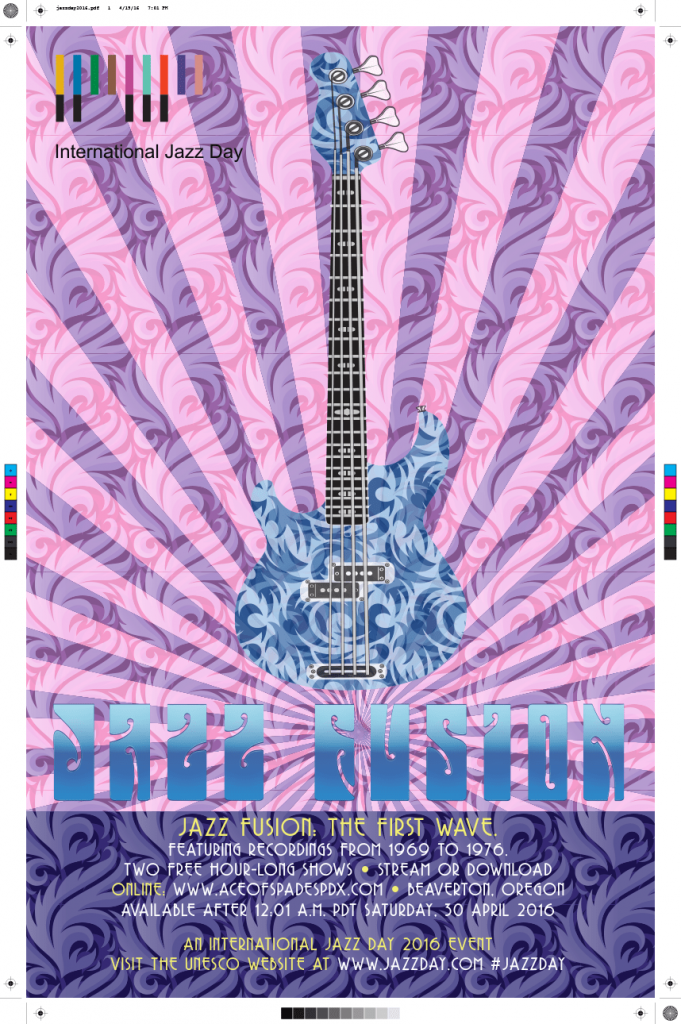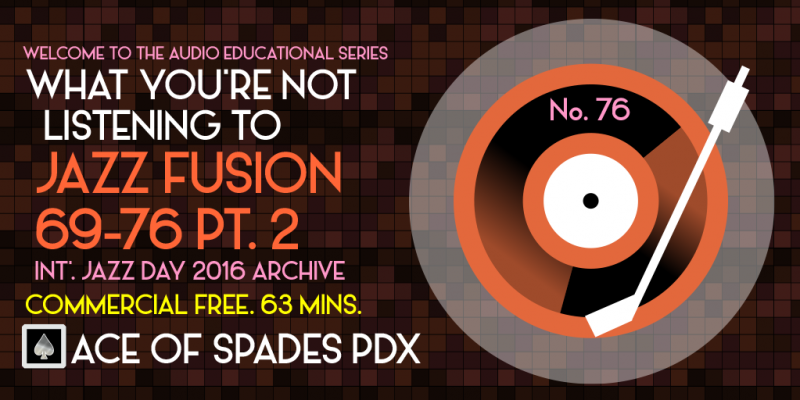Podcast: Play in new window | Download | Embed
The second of the two International Jazz Day 2016 promised to all of you I would start bringing out of the archives. #jazzday #JazzFusion #Jazz #JazzRock
Note: Biographical/historical information about each selection follows below the track listing.
Even though the seeds of what we now call the first wave of Jazz Fusion had been sewn for most of the 1960’s, it wasn’t until Bitches Brew by Jazz luminary Miles Davis was released in 1969 did the form first gain widespread notoriety. As with most immediate and radical departures of a signature sound, there were many who derided the genre, and in this instance, as pandering to rock audiences, regardless of the classic Jazz pedigree that many of the biggest names in this new music form carried. Oddly, unlike Jazz or Rock and Roll, the first wave of this hybrid was steadily developing among the Blues, Psychedelic and Progressive Rock scenes of England prior to gaining acceptance in the U.S.
To the uninitiated, the sound of Jazz Fusion is a heady mix of not just traditional Jazz and Rock and Roll, but often with elements of avant grade or Free Jazz sounds, and with some of these artists, an extension as well of R&B and the then newly emerging Funk sound. Most notably, Jazz Fusion is the sound of Jazz going completely electric; this also meant amplification and a volume at times that would rival many of the major heavy groups of the period. Additionally, Fusion brought new musical instruments into the realm of Jazz that were previously unheard of, such as the violin, the electric bass and synthesizers, sometimes at the expense of brass instruments, which had previously been a mainstay.

Regardless of the derision by so-called “purists”, Fusion also brought Jazz music and Jazz musicians onto stages typically only reserved for the most successful Pop and Rock acts for the first time in United States.
First Part
- Stratus, 1973, Billy Cobham, Spectrum
- 1916/Elastic Rock, 1970, Nucleus, Elastic Rock
- Emergency, 1969, The Tony Williams Lifetime, Emergency!
Second Part
- Eurydice, 1971, Weather Report, Weather Report
- Freeway Jam (live), recorded 1976, released 1977, Jeff Beck, Jeff Beck with the Jan Hammer Group Live
- Moon Dreams, 1973, Flora Purim, Butterfly Dreams
Finale
- Miles Runs the Voodoo Down, 1969, Miles Davis, Bitches Brew
Biographical/Historical Info Pt. 1
First Part
- Stratus, 1973, Billy Cobham, Spectrum
The first solo outing for the former drummer of the Mahavishnu Orchestra, this release features Tommy Bolin on guitar. Bolin would again work with another Jazz Fusion drummer, Alphonse Mouzon of Eleventh House, before his last gig, which was with heavy rock group Deep Purple. Additionally, Jan Hammer also plays on this track.
- 1916/Elastic Rock, 1970, Nucleus, Elastic Rock
Founded by Ian Carr, Nucleus was a British Jazz Fusion band with an eventual 20 year history. Carr had previously been in the psychedelic and progressive rock scenes in the U.K. prior to his founding the band. Their fame rose fairly quickly among music aficionados after winning first prize in their first year of existence at the world renowned Montreux Jazz Festival in Switzerland.
- Emergency, 1969, The Tony Williams Lifetime, Emergency!
One of the few power trios ever in Jazz Fusion, this band was led by a former Blue Note recording artist, drummer Tony Williams. Rounding out the initial trio were organist Larry Young and guitarist John McLaughlin, who was introduced to Miles Davis by Williams. The sound of this album is also not common among Jazz Fusion releases, is much more raw and akin to the feedback laden sounds of garage rock.
Second Part
- Eurydice, 1971, Weather Report, Weather Report
The last track on their debut LP, Weather Report was founded by saxophonist Wayne Shorter, who had already accumulated an impressive series of albums in traditional Jazz forms prior to starting his fusion group, most notably on the classic Speak No Evil. Weather Report would go through several distinct line-up changes, and would almost single-handedly lead the second wave of Jazz Fusion in 1977 with the album Heavy Weather, featuring Jaco Pastorius on bass.
- Freeway Jam (live), recorded 1976, released 1977, Jeff Beck, Jeff Beck with the Jan Hammer Group Live
Listed at #5 of the greatest guitarists of all time by Rolling Stone magazine, Beck had cemented his status as a leading figure in Rock and Roll before turning his attention of a series of highly successful mid-1970’s Jazz Fusion albums. Jan Hammer, whom Beck had taken on the road to play before stadium sized venues, would go on to record one of the biggest pop singles of 1985, the theme to the television series Miami Vice. Hammer originally hails from the country we used to call Czechoslovakia.
- Moon Dreams, 1973, Flora Purim, Butterfly Dreams
One of the few female artists to lead on Jazz Fusion recordings, Purim, a Brazilian native and married to world renown percussionist Airto Moreira, with whom she often collaborates with, found her first success in this genre after recording on the first two Return to Forever albums. She has been the recipient of one of Brazil’s most prestigious awards, the Ordem do Rio Branco and is known as the Queen of Brazilian Jazz.
Finale
- Miles Runs the Voodoo Down, 1969, Miles Davis, Bitches Brew
This was album that blew the door wide open for Jazz Fusion in terms of recognition by the general public. It is an album that has divided Jazz fans for decades, but brought a newfound acceptance of Jazz by the general public, resulting in the very first gold record Miles Davis, originally from Illinois, ever received. Davis was probably the most innovative artist in Jazz history, never afraid to follow his muse or take extreme risks with his career.
Love to you all.
Ben “Daddy Ben Bear” Brown Jr.
Host, Show Producer, Webmaster, Audio Engineer, Researcher, Video Promo Producer and Writer
“Copyright Disclaimer Under Section 107 of the Copyright Act 1976, allowance is made for ‘fair use’ for purposes such as criticism, comment, news reporting, teaching, scholarship, and research. Fair use is a use permitted by copyright statute that might otherwise be infringing. Non-profit, educational or personal use tips the balance in favor of fair use.”
